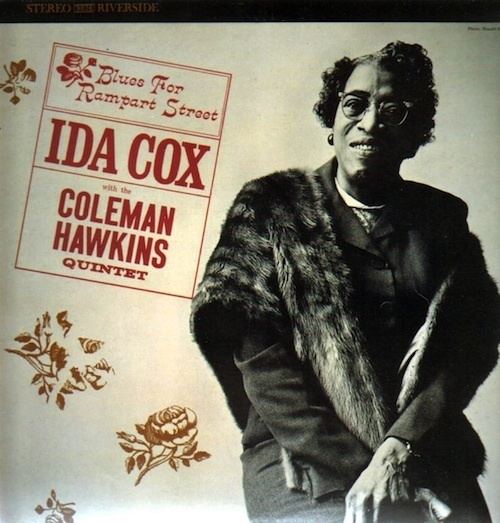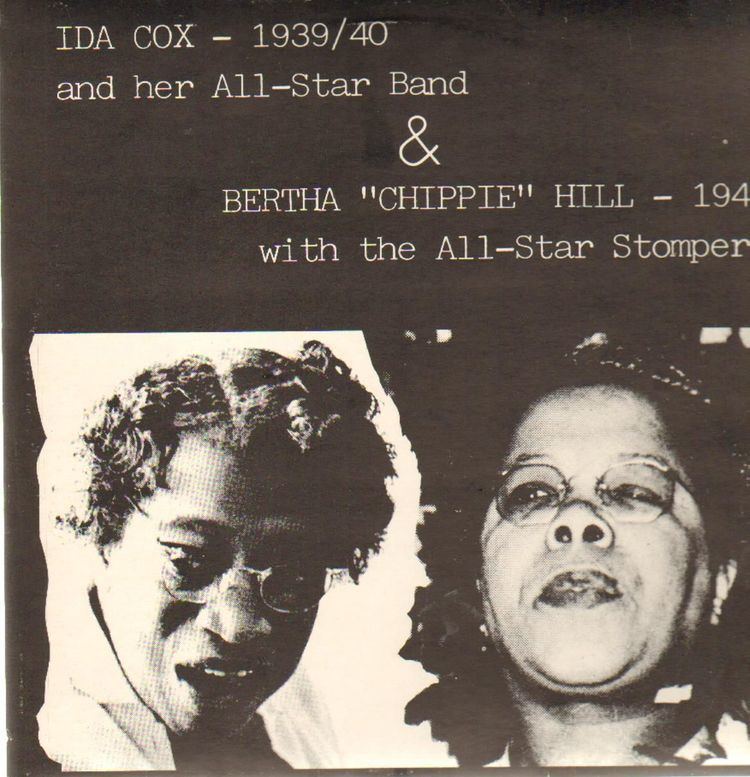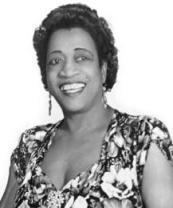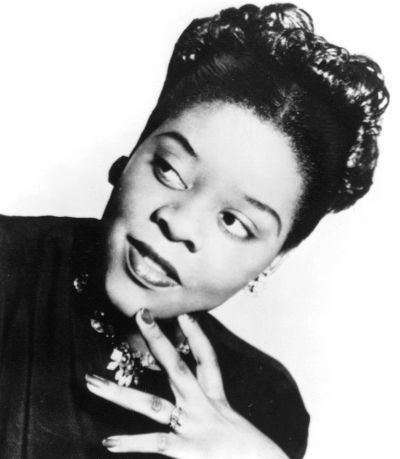Birth name Ida Prather Name Ida Cox Role Singer | Instruments Vocalist Children Helen Williams Years active 1910s–1960 | |
 | ||
Born February 25, 1896Toccoa, Georgia, U.S. ( 1896-02-25 ) Albums Uncrowned Queen, The Uncrowned Queen of the Blues Parents Susie Knight Prather, Lamax Prather Similar People Papa Charlie Jackson, Ma Rainey, Lovie Austin, King Oliver, Johnny Dodds | ||
Ida Cox-Four Day Creep
The Best of Ida Cox
Ida Cox (February 26, 1888 or 1896 – November 10, 1967) was an African-American singer and vaudeville performer, best known for her blues performances and recordings. She was billed as "The Uncrowned Queen of the Blues".
Contents
- Ida Cox Four Day Creep
- The Best of Ida Cox
- Childhood and early career
- Personal life
- Gaining popularity
- Recording career
- Raisin Cain
- Later career and comeback
- Singing style
- Independent spirit
- Legacy and cultural significance
- Discography
- References

Childhood and early career

Cox was born Ida M. Prather, the daughter of Lamax and Susie (Knight) Prather, sharecroppers in Toccoa, Habersham County, Georgia, and grew up in Cedartown, Polk County, Georgia. Many sources give her birth date as February 26, 1896, but the researchers Bob Eagle and Eric LeBlanc have suggested she was born in 1888 and noted other evidence suggesting 1894. Her family lived and worked in the shadow of the Riverside Plantation, the private residence of the wealthy Prather family, from which her namesake came. She faced a future of poverty and few educational and employment opportunities.

Cox joined the local African Methodist Choir at an early age and developed an interest in gospel music and performance. At the age of 14, she left home to tour with White and Clark's Black & Tan Minstrels. She began her career on stage by playing Topsy, a "pickaninny" role commonly performed in vaudeville shows of the time, often in blackface. Cox's early experience with touring troupes included stints with other African-American travelling minstrel shows on the Theater Owners Booking Association vaudeville circuit: the Florida Orange Blossom Minstrels, the Silas Green Show, and the Rabbit Foot Minstrels.

The Rabbit Foot Minstrels, organized by F. S. Wolcott and based after 1918 in Port Gibson, Mississippi, were important not only for the development of Cox’s performing career but also for launching the careers of her idols Ma Rainey and Bessie Smith. Known colloquially as the Foots, the troupe provided a nurturing environment in which Cox developed her stage presence, but life on the vaudeville circuit was trying for performers and workers alike. Paul Oliver wrote, in The Story of the Blues, "The 'Foots' travelled in two cars and had an 80' x 110' tent which was raised by the roustabouts and canvassmen, while a brass band would parade in town to advertise the coming of the show....The stage would be of boards on a folding frame and Coleman lanterns – gasoline mantle lamps – acted as footlights. There were no microphones; the weaker voiced singers used a megaphone, but most of the featured women blues singers scorned such aids to volume." When she was not singing, Cox performed as a sharp-witted comedian in vaudeville variety shows, gaining valuable stage experience and cultivating her stage presence.
Personal life
By 1908 (though some sources suggest 1916), she had married Adler Cox, who performed as a trumpeter with the Florida Orange Blossom Minstrels, a group with which she briefly toured. Their marriage was cut short by his death in World War I. She kept his surname for the rest of her performing career.

In the early 1920s, she married Eugene Williams and gave birth to a daughter, Helen. Few other details are known of this marriage, which ended in divorce.
In 1927 she married Jesse “Tiny” Crump, a blues piano accompanist active on the Theater Owners Booking Association vaudeville circuit. Crump collaborated with her in the composition of many songs, including “Gypsy Glass Blues” and “Death Letter Blues,” provided piano and organ accompaniment on several of her recordings, and served as manager of her blossoming career In the following years.
Gaining popularity
By 1915, Cox had advanced from the pickaninny roles of her early minstrel years to singing the blues almost exclusively. In 1920, she left the vaudeville circuit briefly to appear as a headline act at the 81 Theatre in Atlanta, Georgia, with the great blues pianist Jelly Roll Morton. Her commanding stage presence and expressive delivery earned Cox star billing, and by the early 1920s she was regarded as one of the finest solo acts offered by the shows that travelled the Theater Owners Booking Association circuit. In March 1922 a performance by Cox at the Beale Street Palace, in Memphis, Tennessee, was aired on radio station WMC, with positive reviews, leading to exposure to a wider audience.
Recording career
After the success of Mamie Smith's 1920 recording of "Crazy Blues", record companies became aware of a demand for recordings of race music. The classic female blues era had begun and would extend through the 1920s. With her popularity in the South rapidly increasing, Cox caught the attention of talent scouts and secured a contract with Paramount Records, the same company for which her idol Ma Rainey recorded. Paramount touted Cox as "The Uncrowned Queen of Blues,” a title that she proved was deserved though her prolific recording career. Between September 1923 and October 1929, she recorded 78 titles for Paramount. For her numerous recording sessions, Paramount provided Cox with outstanding backup musicians, including the pianist Lovie Austin and her band, the Blues Serenaders, featuring Jimmy O'Bryant (clarinet) and Tommy Ladnier (cornet). During this period, Cox also recorded songs for other labels, including Broadway Records and Silvertone Records, using the pseudonyms Kate Lewis, Velma Bradley, Julia Powers, and Jane Smith.
Raisin’ Cain
In 1929, Cox and Crump formed their own tent show revue, aptly named Raisin’ Cain (after the biblical story of Cain and Abel and the resulting colloquialism). Cox performed as the title act, and Crump served as both accompanist and manager. Through the end of the 1920s and into the early 1930s, Raisin’ Cain toured black theaters across the Southeast and westward through Texas, with shows in Florida, Alabama, Tennessee, Texas, Missouri, and Oklahoma, and performed several times in Chicago. The show had sixteen chorus girls, comics, and backup singers. The Raisin’ Cain tent show proved so popular that in 1929 it became the first show associated with the Theater Owners’ Booking Association circuit to open at the famed Apollo Theater, in Harlem, New York. Cox, sometimes billed as the "Sepia Mae West", headlined touring companies into the 1930s. This was the pinnacle of her performing career.
By the end of the decade, the economic hardships of the Great Depression and the waning popularity of female blues singers made it difficult to maintain performances of the show, with frequent layoffs and gaps in its touring schedule. Other blueswomen all but disappeared from public performance, but Cox continued her performing career through the 1930s. In 1935, she and Crump reorganized Raisin’ Cain, which by then had been renamed Darktown Scandals, and continued to tour the South and Midwest until 1939. In the early 1930s, the notable American rock-and-roll and R&B drummer Earl Palmer entered show business as a tap dancer in Cox's Darktown Scandals revue.
Later career and comeback
The year 1939 proved to be an industrious and successful one for Cox. She was invited to participate in the historic Carnegie Hall concert series From Spirituals to Swing, produced by John Hammond, in which she sang "Four Day Creep", backed by James P. Johnson (piano), Lester Young (tenor saxophone), Buck Clayton (trumpet), and Dicky Wells (trombone), It was a highlight of the concert series and gave her performing career a much-needed boost after the Depression-era decline. Cox resumed recording, with a series of sessions for Vocalion Records in 1939 and Okeh Records in 1940, with groups that at various times included the guitarist Charlie Christian, the trumpeters Hot Lips Page and Henry "Red" Allen, the trombonist J. C. Higginbotham, and the percussionist Lionel Hampton. She continued to perform until 1945, when she was forced into retirement after a debilitating stroke, which occurred during a performance at a nightclub in Buffalo, New York. She moved to Knoxville, Tennessee, where she lived with her daughter, Helen Goode, and became active in her church.
Cox effectively disappeared from the music world until 1959, when John Hammond placed an ad in Variety magazine in search of her. After locating her, Hammond and the record producer Chris Albertson urged her to make another recording, and in 1961, 15 years after her last sessions, she recorded the album Blues for Rampart Street for Riverside Records, backed by an all-star group composed of Roy Eldridge, Coleman Hawkins, the pianist Sammy Price, the bassist Milt Hinton, and the drummer Jo Jones. The album contained songs from her old repertoire, including "Wild Women Don't Have the Blues", which found a new audience, including the singers Nancy Harrow and Barbara Dane, who recorded their own versions of the song. A review in the New York Times said that Cox at the age of 65 had lost quality in range and intonation but retained her charismatic and expressive delivery of many of the classic tunes that had launched her into stardom.
Cox referred to the album as her "final statement". After recording it, she returned to Knoxville to live with her daughter. She had another stroke in 1965. In 1967, she entered East Tennessee Baptist Hospital, where she died of cancer on November 10, 1967, aged 71. She was buried in Longview Cemetery, in Knoxville.
Singing style
Consistent with her early career, Cox's style leaned more toward vaudeville than blues. She had a less powerful and less rugged voice than her better-known contemporaries Bessie Smith and Ma Rainey, but she held her audiences spellbound with the fiery spirit of her delivery. At the height of the classic female blues era, competition was stiff, with numerous talented blueswomen performing, and Cox's singing was only part of her act. Nevertheless, as her career developed, she assumed and embodied the title bestowed on her, “The Uncrowned Queen of the Blues”. Onstage, she exuded a glamorous sophistication and confidence that captivated her fans. She also embellished her stage presence with a stylish wardrobe, which often included a tiara, cape and rhinestone wand.
Independent spirit
The independent spirit that governed Cox's life and career was a characteristic shared by many early blues stars, including Bessie Smith, Ma Rainey, Sippie Wallace, and Victoria Spivey. Forced to exercise independence from an early age as a result of her teenage career in the minstrel circuits, Cox proved herself as an independent and astute businesswoman through her ability to organize and maintain her own troupe, Raisin’ Cain, which lasted for a decade. She broke barriers in this regard, as virtually no black women owned and managed their own businesses in the 1920s and 1930s. She was one of the few female blues singers of the time to write her own songs.
Legacy and cultural significance
Through her raw and sharp lyricism, Cox in her songs described the complex social realities of poor and working class African Americans in the early twentieth century. Her songs address topics of female independence, sexual liberation, and the social and political struggles of black Americans from a decidedly female perspective that became her trademark. One of Cox's most famous and enduring songs, "Wild Women Don't Have the Blues", is remembered as one of the earliest feminist anthems:
I've got a disposition and a way of my own,
When my man starts to kicking I let him find a new home,
I get full of good liquor, walk the street all night
Go home and put my man out if he don’t act right
Wild women don't worry,
Wild women don't have the blues.
Discography
Complete Recorded Works, vol. 1, Paramount, 1923, re-released by Document Records, 1997
Complete Recorded Works, vol. 2, Paramount, 1924, re-released by Document Records, 2000
Complete Recorded Works, vol. 3, Paramount, 1925, re-released by Document Records, 2000
Complete Recorded Works, vol. 4, Paramount, 1927, re-released by Document Records, 2000
Blues for Rampart Street, Original Jazz Classics, 1961
Ida Cox: The Essentials, Classic Blues, 2001
